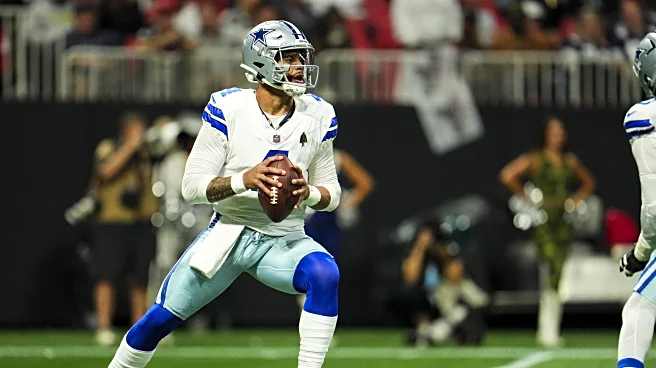What is the story about?
What's Happening?
Fantasy football experts are analyzing trends to predict the top running back for the 2025 season. Historical data shows that no running back older than 27 has finished as the overall RB1 since 2007, eliminating notable players like Saquon Barkley and Christian McCaffrey from contention. Analysts are focusing on metrics such as average draft position (ADP), fantasy points per touch, and yards per touch to identify potential candidates. Jahmyr Gibbs, De'Von Achane, Bucky Irving, and James Cook have emerged as top contenders based on these criteria. Gibbs, for instance, was the RB1 in PPR formats last season, while Achane's performance is closely tied to quarterback Tua Tagovailoa's health.
Why It's Important?
The identification of top running back candidates is crucial for fantasy football enthusiasts as it influences draft strategies and player selections. Understanding these trends helps players make informed decisions, potentially leading to successful fantasy seasons. The analysis also highlights the evolving nature of running back roles in the NFL, with fewer players receiving high workloads compared to previous decades. This shift impacts team strategies and player valuations, affecting both real-world NFL dynamics and fantasy football outcomes.
What's Next?
As the NFL season approaches, fantasy football players will continue to monitor preseason performances and injury reports to refine their draft strategies. The identified candidates will be closely watched for any changes in their roles or team dynamics that could affect their fantasy value. Additionally, the ongoing analysis of historical trends may lead to new insights and adjustments in player rankings, influencing draft decisions and trade negotiations throughout the season.
Beyond the Headlines
The analysis of running back trends also reflects broader shifts in NFL strategies, with teams increasingly relying on committee approaches rather than single bell cow backs. This change may influence contract negotiations and player career trajectories, as running backs adapt to new roles and expectations. Furthermore, the focus on metrics like fantasy points per touch underscores the growing importance of efficiency and versatility in player evaluations, impacting how teams scout and develop talent.
AI Generated Content
Do you find this article useful?












